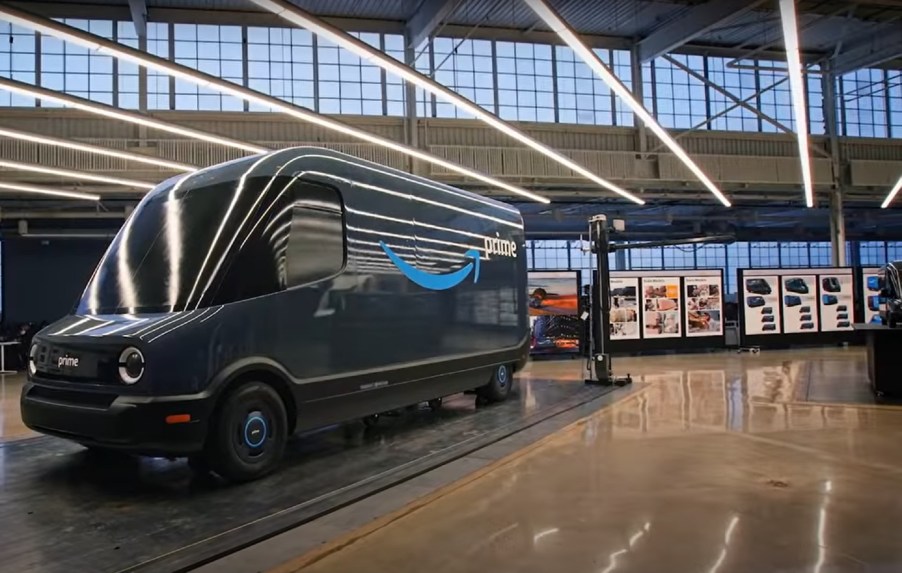
Rivian May Soon Offer an Electric Van and Faster Charging
Though its SUV project with Lincoln is dead, Rivian is still developing its EVs in other ways. And not just by making the R1T pickup and R1S SUV cheaper than expected, or adding a tank turn feature. New trademarks hint that the company might be adding an electric van and crossover to its lineup. And that said models will charge even faster than a Taycan.
Rivian’s potential electric van and crossover models
In addition to the R1T and R1S, Rivian has also filed trademarks for 2 additional vehicles, Motor Trend reports. Reportedly, these EVs will be called ‘R1V’ and ‘R2X.’

Considering the R1T is a truck, and the R1S an SUV, it’s likely the R1V will be an electric van. We’ve already known about Rivian producing electric vans for Amazon. So, it’s possible ‘R1V’ is just what those vans will be called, InsideEVs muses. But it’s possible this is a passenger version of those commercial vans.

The R2X’s identity, meanwhile, is a bit murkier. RivianOwnerForums.com users muse that it could be an electric minivan. However, MT and InsideEVs believe it could be a less-expensive electric crossover.
In October 2019, we reported on an unnamed Rivian styling buck spotted while the R1T was undergoing testing. At the time, it was believed to be the high-ground-clearance ‘rally EV’ Rivian CEO RJ Scaringe had hinted at. Considering that rumored EV would’ve basically been a shortened R1S, the electric crossover idea makes some sense.
But the potential electric van and crossover trademarks aren’t the only Rivian news.
Rivian’s fast charging patent
Arguably, the best solution to range anxiety isn’t actually a larger battery, but more fast chargers. But Rivian isn’t building more chargers. Instead, a battery patent indicates Rivian is focusing on raising charging speeds, Trucks.com reports.

Rivian’s patent describes a battery with a mechanism that allows it to charge at higher voltages than it’s technically rated for. So, for example, a 450V pack could charge like a 900V one, InsideEVs explains. The reason why the Porsche Taycan can charge so quickly, Car and Driver explains, is because it’s rated at a higher-than-normal 800V. Raising voltage means the current can be lower, which lowers charging time. However, building an EV like that requires more-expensive batteries and components.
But Rivian’s proposed system would allow a less-expensive battery to charge like the Taycan’s. Or even faster. The Taycan tops out at a 270-kW charging rate. Rivian, though, claims its EVs can handle 300 kW, InsideEVs reports. In addition, the mechanism can supposedly by-pass detected battery faults.
How realistic is all this?
According to MT, a Rivian spokesperson said that, “’ trademarks aren’t vehicle programs” and that Rivian files such applications ‘for all kinds of stuff.’” So, it’s possible that the R1V, R2X, and battery patents won’t actually lead to physical products. However, Rivian does have some incentive to follow through.

On the subject of the electric van, many other automakers have produced passenger versions of commercial vans. This includes GM, Mercedes-Benz, and Ford. Not to mention other EV companies, like Bollinger, are branching out their passenger platforms to commercial customers. So, an electric panel van for non-commercial buyers isn’t at all far-fetched. GM’s even working on one.

Regarding the R2X, there’s an argument to be made for either minivan or crossover versions. Toyota and Chrysler both offer hybrid minivans, but no one’s offering a purely-electric one. And even if it’s not ‘rally-style,’ a less-expensive crossover would let Rivian compete with the likes of the Fisker Ocean. Not to mention the recently-released Tesla Model Y. Between the minivan and crossover, though, the latter makes more sense. It’s the more-popular segment.

As for the switchable battery, that’s more difficult to gauge. If the goal is to make EVs affordable for all, lowering costs is vital. And in terms of achievability, it seems like it would be easier to implement than introducing new battery chemistry. On the other hand, cheaper and faster-charging batteries mean little if there aren’t enough chargers to go around.
Considering the R1T and R1S still aren’t officially in production, let’s see what the next few months bring for Rivian.
Follow more updates from MotorBiscuit on our Facebook page.


